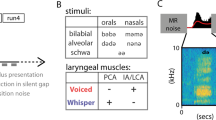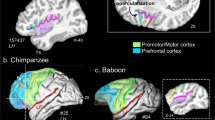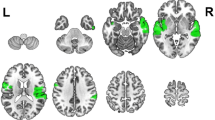Abstract
THE cause of stuttering is unknown1. Failure to develop left-hemispheric dominance for speech is a long-standing theory1 although others implicate the motor system more broadly2, often postulating hyperactivity of the right (language non-dominant) cerebral hemisphere3. As knowledge of motor circuitry has advanced4, theories of stuttering have become more anatomically specific, postulating hyperactivity of premotor cortex, either directly5 or through connectivity with the thalamus and basal ganglia6. Alternative theories target the auditory7 and speech production8,9 systems. By contrasting stuttering with fluent speech using positron emission tomography combined with chorus reading to induce fluency, we found support for each of these hypotheses. Stuttering induced widespread over-activations of the motor system in both cerebrum and cerebellum, with right cerebral dominance. Stuttered reading lacked left-lateralized activations of the auditory system, which are thought to support the self-monitoring of speech, and selectively deactivated a frontal–temporal system implicated in speech production. Induced fluency decreased or eliminated the overactivity in most motor areas, and largely reversed the auditory-system underactivations and the deactivation of the speech production system. Thus stuttering is a disorder affecting the multiple neural systems used for speaking.
This is a preview of subscription content, access via your institution
Access options
Subscribe to this journal
Receive 51 print issues and online access
$199.00 per year
only $3.90 per issue
Buy this article
- Purchase on Springer Link
- Instant access to full article PDF
Prices may be subject to local taxes which are calculated during checkout
Similar content being viewed by others
References
Bloodstein, O. A Handbook on Stuttering (Singular Group, San Diego, 1995).
Zimmermann, G. J. Speech Hear. Res. 23, 122–136 (1980).
Yeudall, L. T. Semin. Speech Lang. 6, 197–231 (1985).
Alexander, G. E., DeLong, M. R. & Strick, P. L. A. Rev. Neurosci. 9, 357–381 (1986).
Webster, W. G. in Neuropsychology of Stuttering (ed. Boberg, E.) 73–127 (University of Alberta, Edmonton, 1993).
Caruso, A. J. in Speech Motor Control and Stuttering (eds Peters, H. F. M., Hulstijn, W. & Starkweather, C. W.) 101–116 (Excerpta Medica, Amsterdam, 1991).
Stromsta, C. Elements of Stuttering (Oshtemo Michigan, Atsmonts, 1986).
Perkins, W. H., Kent, R. & Curlee, R. D. J. Speech Hear. Res. 34, 734–752 (1991).
Wingate, M. The Structure of Stuttering: A Psycholinguistic Analysis (Springer, New York, 1988).
Ingham, R. J. Stuttering and Behavior Therapy: Current Status and Experimental Foundations (College Hill, San Diego, 1984).
Ingham, R. J., Cordes, A. K. & Finn, P. J. Speech Hear. Res. 36, 1168–1176 (1993).
Petersen, S. E., Fox, P. T., Posner, M. I., Mintun, M. & Raichle, M. E. J. cogn. Neurosci. 1, 153–170 (1989).
Pardo, J. V. & Fox, P. T. Hum. Brain Mapp. 1, 57–68 (1993).
Fairbanks, G. J. Speech Hear. Disord. 19, 133–139 (1954).
Fox, P. T., Fox, J. M., Raichle, M. E. & Burde, R. M. J. Neurophysiol. 52, 348–368 (1985).
Grafton, S. T. Ann. Neurol. 36, 3–4 (1994).
Posner, M. I., Petersen, S. E., Fox, P. T. & Raichle, M. E. Science 240, 1627–1631 (1988).
Frith, C. D., Friston, K. J., Liddle, P. F. & Frackowiak, R. S. J. Neuropsychologia 29, 1137–1148 (1991).
Wise, R. J. et al. Brain 114, 1803–1817 (1991).
Friston, K. J., Frith, C. D., Liddle, P. F. & Frackowiak, R. S. J. Proc. R. Soc. Lond. B 244, 101–106 (1991).
Zimmermann, G. in Nature and Treatment of Stuttering: New Directions (eds Curlee, R. W. & Perkins, W. H.) 131–147 (College Hill, San Diego, 1984).
Fox, P. T., Mintun, M. A., Raichle, M. E. & Herscovitch, P. J. cereb. Blood Flow Metab. 4, 329–333 (1984).
Fox, P. T. & Mintun, M. A. J. nuclear Med. 30, 141–149 (1989).
Fox, P. T., Perlmutter, J. S. & Raichle, M. E. J. Comput. assist. Tomogr. 9, 141–153 (1985).
Talairach, J. & Tournoux, P. Co-planar Stereotaxic Atlas of the Human Brain (Springer, Thieme, 1988).
Fox, P. T., Mintun, M. A., Reiman, E. M. & Raichle, M. E. J. cereb. Blood Flow Metab. 8, 642–653 (1988).
Ingham, R. J. & Packman, A. J. Speech Hear. Res. 22, 784–793 (1979).
Cordes, A. K. & Ingham, R. J. J. Speech Hear. Res. 38, 33–41 (1995).
Van Riper, C. & Hull, C. J. in Stuttering in Children and Adults (eds Johnson, W. & Leutenegger, R. R.) 199–206 (Univ. Minnesota Press, Minneapolis, 1955).
Mintun, M. A., Fox, P. T. & Raichle, M. E. J. cereb. Blood Flow Metab. 9, 96–103 (1989).
Author information
Authors and Affiliations
Rights and permissions
About this article
Cite this article
Fox, P., Ingham, R., Ingham, J. et al. A PET study of the neural systems of stuttering. Nature 382, 158–162 (1996). https://doi.org/10.1038/382158a0
Received:
Accepted:
Issue Date:
DOI: https://doi.org/10.1038/382158a0
This article is cited by
-
Towards real-world generalizability of a circuit for action-stopping
Nature Reviews Neuroscience (2021)
-
Complexity-Based Analysis of the Difference Between Normal Subjects and Subjects with Stuttering in Speech Evoked Auditory Brainstem Response
Journal of Medical and Biological Engineering (2019)
-
Shifted dynamic interactions between subcortical nuclei and inferior frontal gyri during response preparation in persistent developmental stuttering
Brain Structure and Function (2018)
-
Hemodynamics of speech production: An fNIRS investigation of children who stutter
Scientific Reports (2017)
-
Altered functional connectivity in persistent developmental stuttering
Scientific Reports (2016)
Comments
By submitting a comment you agree to abide by our Terms and Community Guidelines. If you find something abusive or that does not comply with our terms or guidelines please flag it as inappropriate.



